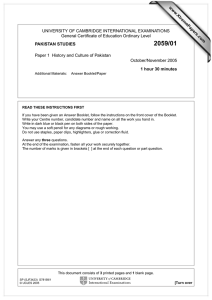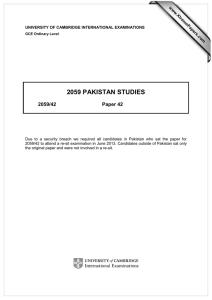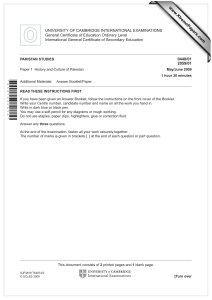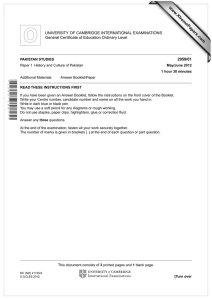www.XtremePapers.com
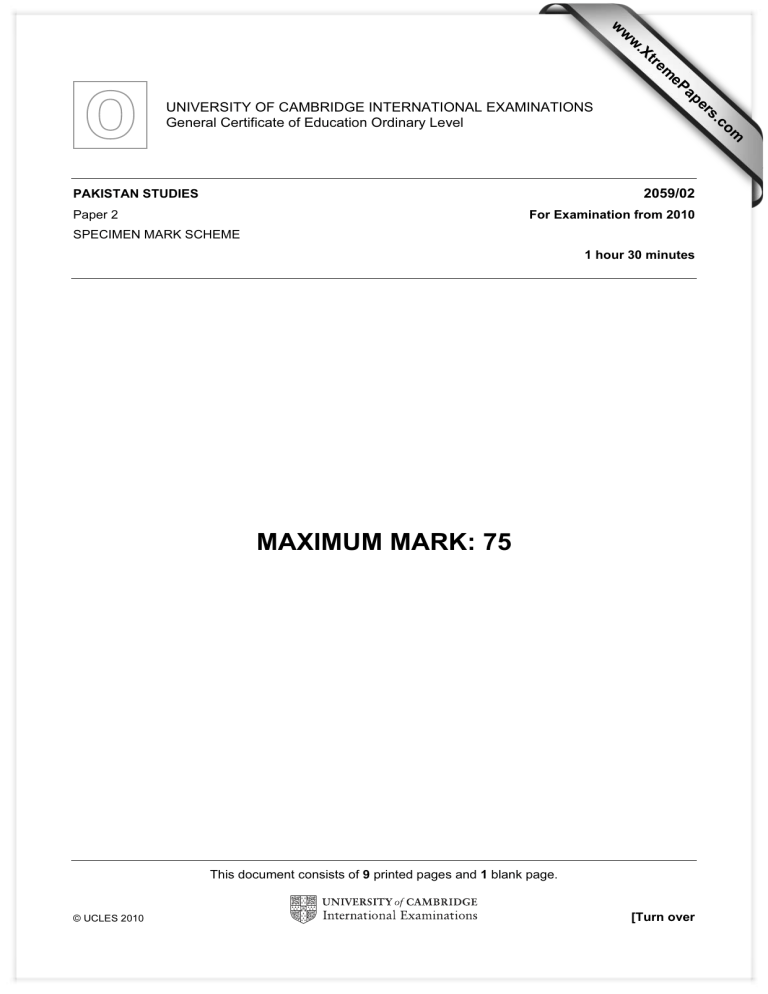
www.XtremePapers.com
UNIVERSITY OF CAMBRIDGE INTERNATIONAL EXAMINATIONS
General Certificate of Education Ordinary Level
PAKISTAN STUDIES
Paper 2
SPECIMEN MARK SCHEME
2059/02
For Examination from 2010
1 hour 30 minutes
MAXIMUM MARK: 75
© UCLES 2010
This document consists of 9 printed pages and 1 blank page.
[Turn over
2
1 (a) Study Fig. 1, which shows the climate of Misgar, in the Karakoram Mountains.
(i) In which month is the highest precipitation?
May
(ii) How much precipitation falls in this month?
(iii) For how many months is the precipitation more than 9 mm?
6
(iv) Describe the temperature changes through the year below zero January, February and December lowest of –7 °C in January increases to 19 °C in August decreases to zero in November
(b) Explain why the precipitation increases in July and August.
Caused by the monsoon
Humid air from the Bay of Bengal
Where air pressure is high
Moving from the east or north-east
Towards a low pressure area over the mountains
Caused by heating of the land
[1]
[1]
[1]
[3]
[4]
(c) Explain how farming and industry is affected by the climate and topography of mountain areas such as the Karakorams. You should use your knowledge of mountain areas and figures from Fig. 1 in your answer. [6]
Farming
Transhumance farming due to mountainous topography
Fruit growing in mountain valleys due to milder climate
Terracing of slopes to increase flat land for crop growing in valleys
Storage of food for animals through the winter due to cold temperatures
Lack of water in winter due to sub-zero temperatures
Industry
Small-scale due to difficult access through mountains
Cottage industries due to cold temperatures in winter
© UCLES 2010 2059/02/SM/10
3
(ii) Explain why travel by land and air is difficult in mountainous areas.
Roads and railways blocked especially in winter
Surface damaged by ice and snow
Flooding
Air travel needs runways
Fog and ice limits air travel
(d) What are the advantages and disadvantages of developing tourism in mountain areas?
[5]
Advantages
Increase local incomes
Increase local infrastructure
Opportunities for development
Maintenance of local environment
Preservation of local culture
Disadvantages
Cost of development
Loss of local culture
Small scale clearing of land
May not be successful
2 (a) Study Fig. 2, which shows the location of the Warsak dam.
(i) Name the river across which the Warsak dam is built. [1]
(ii) Name the farming area served by irrigation water from this reservoir.
Swat and Kabul river valleys
Peshawar, Charsadda, Nowshera areas
(iii) Using Fig. 2 and your own knowledge state:
A three physical factors that make this a good site for a reservoir.
[4]
[1]
[3]
Runoff from melting snow and ice
Cool climate/low evaporation
© UCLES 2010 2059/02/SM/10 [Turn over
4
B three reasons why this is not a good site for generating electricity.
Remote/long distance from users
Low population/lack of demand
[3]
Difficulty of building transmission lines
Difficulty of maintain in transmission lines
Lack of skilled labour
(b) Read the following extract.
There are many problems for the development of Pakistan's industries. One of the most severe is that of power supply. Firstly there is its high cost. In addition there is not enough power generated to meet requirements, and an unreliable supply due to frequent breakdowns at the power stations.
(i) Explain the reasons for the high cost of power from thermal stations in Pakistan.
[3]
Fossil fuels expensive
Have to be imported
Cost of machinery/technology
Cost of repairs to old machinery
(ii) Suggest reasons why power stations frequently break down. [2]
Lack of trained mechanics
(iii) Other than 'frequent breakdowns at power stations', why is the supply of power unreliable? [3]
Damage to poles and wires
Shortage of fossil fuel
Stealing along lines
Need for load shedding
Sabotage/damage
(iv) Explain how some factories try to overcome the problem of unreliable electricity supply. [2]
Generators when supplies fail
Use of waste ego bagasse at sugar factories
Planned stoppages when load shedding occurs
© UCLES 2010 2059/02/SM/10
5
(c) Consider the advantages and disadvantages of developing renewable energy supplies in Pakistan. [7]
Advantages
Climatic – sunshine, wind at coast, waves
Will not run out
Cheap after set-up costs
Present shortage/cost of fossil fuels
Will reduce imports
Can be used anywhere/in rural areas
Disadvantages
Expensive to set up
Technology is still being developed
Output usually low
3 (a) Study Fig. 3, which shows the proportion of workforce in the primary, secondary and tertiary sector of industry.
Which of these sectors is labelled
[1]
secondary
[1]
tertiary
(b) Study Fig. 4, which shows the proportion of workforce in the main categories of employment.
(i) Which of these categories of employment has all of its workforce in the primary sector of industry? [1]
agriculture
(ii) Which categories of employment are in the tertiary sector of industry?
Finance and social services
[2]
Wholesale and retail trade
Construction
Transport
(iii) Why are many people unable to get employment in the tertiary sector of industry?
[3]
Illiteracy
Lack of jobs/smallest sector on Fig. 4
Computers replace more than one person
Few opportunities in rural areas/villages
© UCLES 2010 2059/02/SM/10 [Turn over
6
(c) (i) Explain why a large proportion of people work in agriculture.
Large population in rural areas
Opportunities for unskilled
Need for food
Lack of machinery/mostly manual labour
Good agricultural land/fertile soils
[4]
(ii) Why has the proportion of people working in agriculture decreased in recent years? [6]
Mechanisation
Poor working conditions/hard work
Attractions of urban areas/bright lights
More education/people qualified for better jobs
(d) The loss of jobs in agriculture has caused widespread migration to urban areas.
Consider the advantages and disadvantages of providing other types of employment in rural areas. [7]
Advantages
More income/more spending money
Higher living standards
Better power supply/water/sanitation
Disadvantages
Cost of development
4 (a) Study Fig. 5, a sketch map showing the location of important industrial centres in north-east Punjab and their main industries.
(i) Name the three cities with both a dry port and an airport. [3]
(ii) Using Fig. 5 only, describe the route of the main road from Faisalabad to Sialkot.
[3]
East/north east to Skekhupura
North to Gujranwala
North-east to Sialkot
Crosses railway at Shekhupura and Gujranwala
Crosses roads to Lahore
© UCLES 2010 2059/02/SM/10
7
(b) Using Fig. 5 and your own knowledge, describe the physical factors that have led to the growth of industry in the northern Punjab. [6]
Water supply from rivers/barrages
Gently sloping land for building/travel/provision of infrastructure
Fertile soils for cotton/sugar cane
Rainfall for water supply
Pleasant climate for working
(c) (i) State two examples of export goods manufactured in Sialkot.
[1]
Surgical instruments, sports goods, carpets, cloth, jewellery etc. (two for 1 mark)
(ii) Explain how the government can support the continued growth of industries in this area. [6]
Provision of better roads, power supply, other infrastructure
Industrial estates especially EPZs
Education and health schemes
PIDC to invest where private sector was reluctant
Support for small scale/cottage industries
Advertising, trade fairs, trade agreements etc.
Encouraging foreign loans/investment
South west Sindh/Karachi area
(d) To what extent can the improvement of roads, railways and airports increase industrial development in Pakistan? [6]
Benefits
Provision of raw materials/inputs
Better transport of products/outputs
Airports encourage foreign experts to visit
Railways for dry ports/bulk transport
Roads for bigger lorries
Limitations/problems
Cost reduces capital for industrial investment
Cost of maintenance
Other limiting factors, ego skills, technology, need for modernisation of present industries
© UCLES 2010 2059/02/SM/10 [Turn over
8
5 (a) Study Fig. 6, a map showing population density in Pakistan.
Describe and explain the distribution of areas of population density more than 200 persons per square kilometre. [5]
Description
North East and Central Punjab
Valleys of the 4 rivers east of the Indus
Central NWFP/W-E band through the middle
Along Indus Valley
South west Sindh/Karachi area
Explanation
Rural urban migration and reasons
High birth rates
Employment/farming in area (other than rural-urban migration)
(b) (i) Explain why Pakistan has a high rate of population growth. [4]
High birth rate and reasons
Decreasing death rate and reasons
Refugees
(ii) State and explain two problems caused by the high rate of population growth in
Pakistan. [6]
Problems
Unemployment – lack of skills, mechanisation of agriculture and industry, division of land etc.
Hunger/starvation – lack of fertile land, lack of irrigation, rural urban migration etc.
Overpopulation – lack of resources, food, housing, land
Lack of healthcare – illness, unfit for work, high infant mortality
Lack of education/illiteracy – low farm outputs, shortage of skills, lack of doctors, teache
Lack of housing – poor living conditions, overcrowding, illness,
(c) Study Fig. 6 again.
(i) Name the shaded area X.
Makran coast/Gwadar district
[1]
© UCLES 2010 2059/02/SM/10
9
(ii) Why has there been a low population density in area X up to the present day? [3]
Arid climate/no rivers/lack of water
Lack of communications to more prosperous parts of the country/isolated/remote
Poor soil for farming/lack of agriculture
Lack of government investment
(iii) Name the port P. To what extent will the planned development at P increase the density of population in area X? [6]
P – Gwadar
Benefits
Better power supplies
Limitations/problems
Mountain range near coast
Cost of development
Some things cannot be improved ego climate, soil
Low starting point/not much there at present
Will take a long time to develop
© UCLES 2010 2059/02/SM/10
10
BLANK PAGE
© UCLES 2010 2059/02/SM/10

